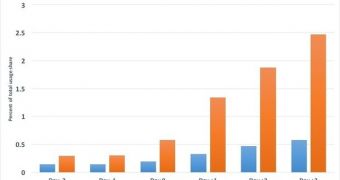Windows 10 was officially released on July 29, and since then millions of users across the world have downloaded it on their systems, and while figures that reach the web are more or less controversial, statistics show that the new OS is performing amazingly well.
Data provided by StatCounter shows that, on Day 1, Windows 10 managed to double its market share, with its adoption going a lot better than for Windows 8.1, an operating system that was often criticized by users and experts alike and described as the company’s second flop after Windows Vista.
Basically, in the morning of July 29, Windows 10 had a market of only 0.3 percent pretty much because of the Windows Insider program, which allowed users to try out the new operating system ahead of its big launch.
On July 29, however, Windows 10 managed to double its market share to 0.6 percent, as Microsoft pushed the button and released the OS to the first users.
2.5 percent market share in just 4 days
Early adoption is going unexpectedly well for Windows 10, with the first days on the market helping the new operating system reach a market share of 2.5 percent, enough not only to overtake rivals such as Linux but also to get very close to Windows Vista and even to Windows 8 (not 8.1).
For the sake of comparison, while Windows 10 had a market share of 2.6 percent on the fourth day after launch, Windows 8.1 was running on only 0.6 percent of the PCs during the same day after its public unveiling.
And it’s really easy to see why Windows 10 is rapidly becoming a hit: Microsoft is not only offering it free of charge to those running genuine Windows 7 or 8.1 but it has also fixed many of the problems that users criticized in the previous OS versions, bringing back features as the Start menu.
These adoption figures are expected to grow even more in the coming weeks, as Windows 10 is now being rolled out to users across the world and more people will upgrade their computers to the new OS.

 14 DAY TRIAL //
14 DAY TRIAL //